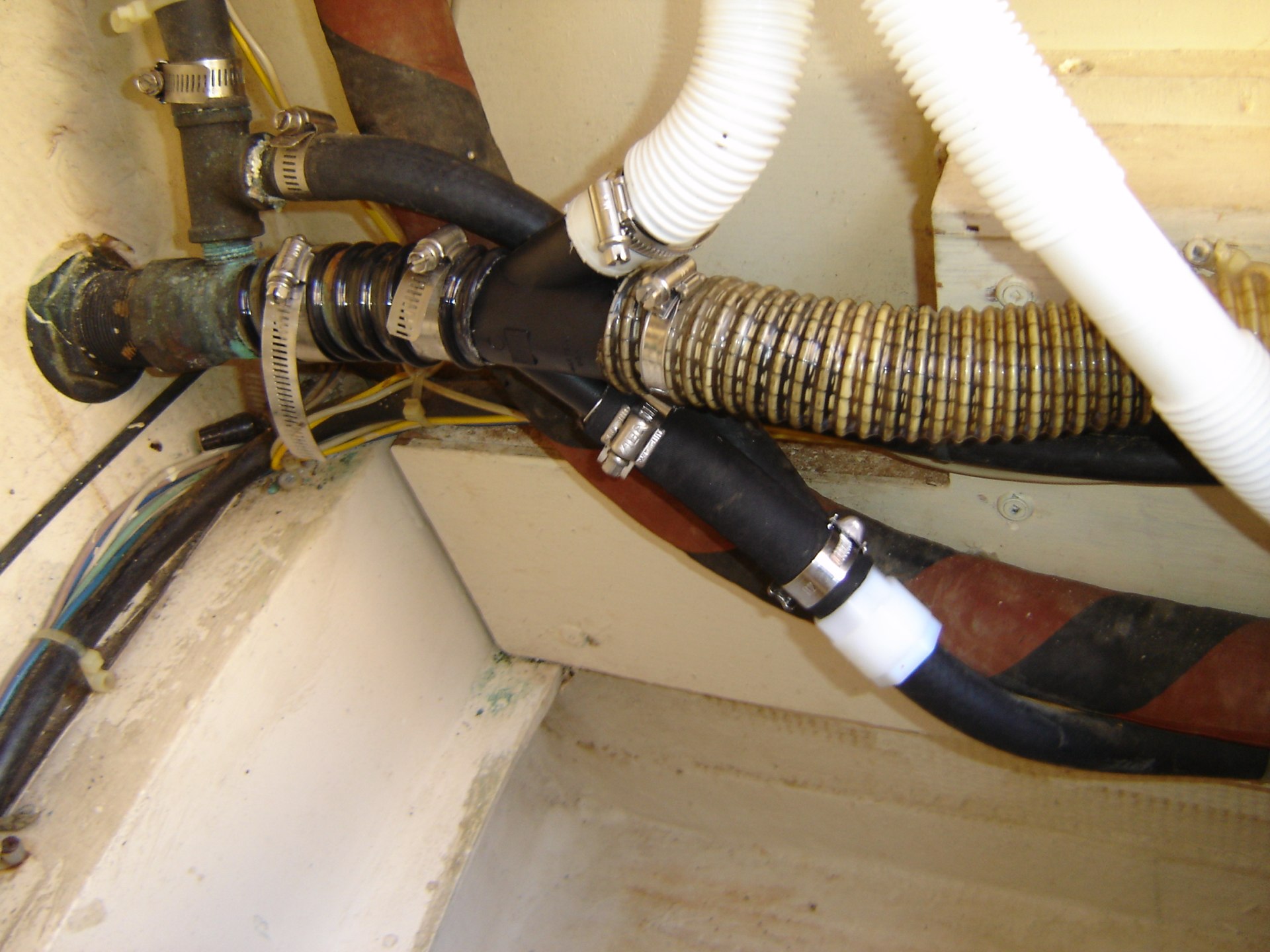The "Five F's" include Flood, Falling Overboard, Fire, First Aid, Famine. Let's wring our hands over flooding. This is a subject which can make one very distraught. It takes some work to be optimistic.
Red Ranger has a number of holes in the hull. All of which are fairly serious business. Reason for Optimism #1: She's been afloat since 1982 and there's no compelling reason for this to change. With a little bit of care, she should continue to float until the next ice age. Seriously, she's made of plastic.
-
Below the waterline, she has nine plumbed through-hulls with bronze sea-cocks. Each of these has heavy-weight high-temperature hose with double stainless steel hose clamps. Each seacock has to be lubricated so that they move. Which, in some cases, is really hard to do. But they all move now. And we have soft wood plugs as well as backup foam plugs for these.
-
She also has a knotmeter that pokes through the bottom. This has two backup plugs in case of problems. A cylindrical plug that exactly matches the knotmeter, plus we have soft foam plugs that can be mashed into the hole in case of emergency.
-
Above the waterline she has engine exhaust, and two air conditioning drains. These have seacocks and double-clamped hoses, also. And backup plugs.
An ounce of prevention is worth a pound of cure. In our case, the designer, the builder (and the owners -- us) have invested heavily in prevention.
The Cure
The cure for flooding is -- obviously -- pumps. The questions are "what kinds?" and "how many?"
The off-the shelf answer is "both": one automatic bilge-pump and one manual bilge pump. Experienced folks like Alvah Simon list close to half-a-dozen bilge pumps including -- in extremis -- buckets.
If there's a 1% chance of failure in an automatic bilge pump, we can improve our odds 100x by installing a second pump and making that a 1 in 10,000 chance of failure. It's what they call "cheap insurance".
Let's talk venery and collective nouns. You have your pride of lions, your brood of chickens, your gaggle of geese, your exaltation of larks. You have your manifold of bilge pumps.
Best Effort
One can worry sick about things like maintaining the through hulls and adding a bilge pump.
The through-hulls are scary: nine of ‘em -- the nine riders -- nine accidents waiting to happen.
Reason for Optimism #2: Each seacock is virtually indestructible. [I know, I had to beat some of them loose with hammers.] Each can be tightened with a wrench until they don't leak and -- perhaps -- cannot be moved. We can easily make safety trump convenience.
Bilge pump wiring can be scary. That crimped-on connector is life-or-death. Did you crimp it properly? Really properly? Will it just fall out?
Actually, while working on Pump #3, one of the crimp-on connectors for pump #1 fell off. Seriously. The existing installation had a cruddy crimp job. (And a wire nut. See Some Jobs Completed.)
I replaced the pair of shoddy crimps with a big old wiring block.
Reason for Optimism #3: My best effort appears to be pretty good. I may worry about the quality of my crimps, but it appears that my crimps are better than some of the crimps there were in place for the last few decades.
Maintainability
The advice from smart people is to add an emergency bilge pump that has a float switch higher than the primary pump. If the first can't keep up, this will help with the overflow. Most say that this should be on a dedicated battery circuit: power goes from battery through a fuse directly to the pump -- no possibility of accidentally turning it off.
Some folks even add a burglar alarm so that the emergency is noisy. Let's not get too crazy. However, it is worth considering.
The other trick is to mount the entire apparatus on a board so it can be pulled up out of the bilge for maintenance. That advice is pure genius.
Drain Manifold
Once we've got a pump, with electricity, we have to have some place for the water to go. There are two choices.
Some folks advocate for drilling yet another through-hull. Other folks suggest simply adding it to the existing pump drain and creating a manifold. We voted for manifold.
Our existing manifold involved three separate drains: the automatic pump #1, the fridge chiller and manual pump #2.
This is relative easy to extend to add one more drain line. This leaves us with a manifold that's only slightly more complex.
It involves a fair number of hose clamps, but it's easy to inspect and readily accessible from the cockpit.
Reasons for Optimism
One of the biggest reasons for optimism was completely accidental. While rooting around in the bilge to install this pump, I decided to try and wash out the bilge. I got a bucket of soapy water and and brush. As I was pouring water into the bilge, the primary pump started up and pumped all my soapy water out.
Dammit! Wait, what? Great! Dammit! The primary pump works! I wish it hadn't worked at that moment, but it worked correctly. Turn off the circuit, get another bucket of soapy water and try again.
She's plastic and has worked wonderfully for years. Her through-hulls are virtually indestructible. My best efforts seem to be pretty good. And -- bonus -- the entire manifold of bilge pumps all work.







